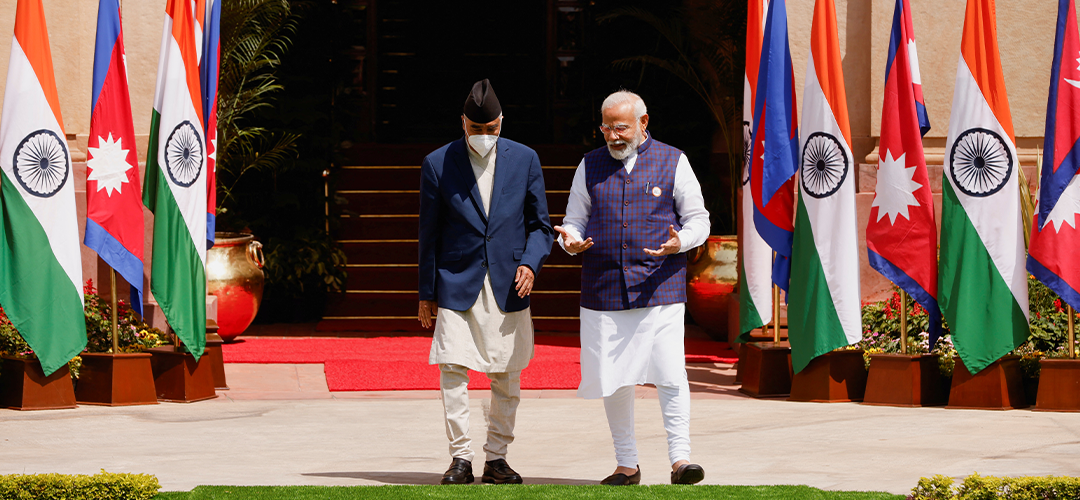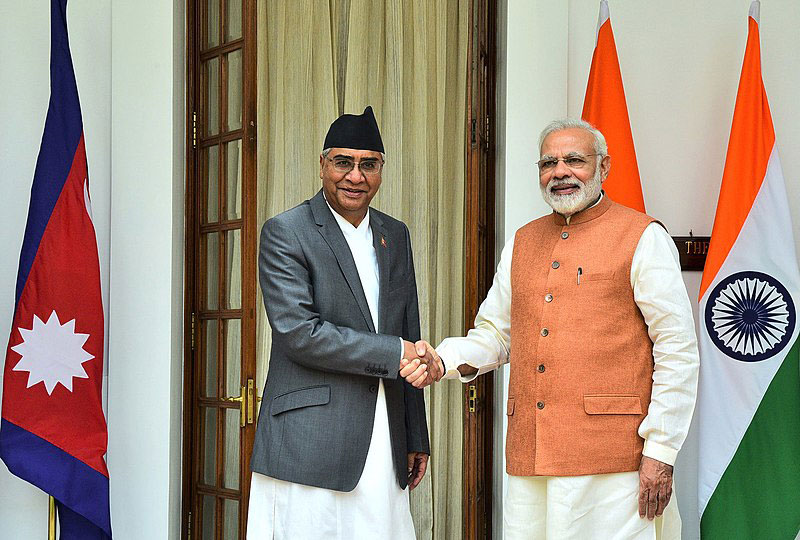Indo-Nepal Ties: on the Mend?
June 24, 2023 | Expert Insights

Nepal’s prime minister Pushpa Kamal Dahal recently made a four-day official trip to India. Invited by Prime Minister Narendra Modi, it was his first visit to India since he took the office of prime minister in December 2022.
Popularly known as Prachanda, the Nepalese prime minister leads the Communist Party of Nepal and has been a source of concern for the Indian government due to his past image. However, his recent visit emphasised cooperation and underplayed points of contention between the two countries.
Background
For a long time, communist-led governments in Nepal have triggered concern in Delhi since they often develop close ties with India's arch-competitor China. Delhi’s worries stem from a genuine concern that a communist-led (and Beijing-supported) government in Kathmandu may run counter to Indian interests vis-a-vis traditional political entities like the Nepali Congress.
During Nepal's general elections in November, Prachanda's Communist Party of Nepal supported the ruling coalition led by Sher Bahadur Deuba's Nepali Congress party, known to be pro-India. When the ruling coalition failed to win a majority, negotiations to form a government began. Sher Bahadur Deuba refused to support Prachanda's bid for the position of prime minister, and the alliance fell apart.
Prachanda then joined with the rival Communist Party of Nepal (United Marxist Leninist), led by KP Sharma Oli, who was willing to prop Prachanda's bid for the Prime Minister's chair. Oli's UML Communist is also a recognised pro-Beijing party under American and Indian scanners for its open support for its bigger neighbour to the North at the expense of its historical Southern partner. However, the budding alliance between Prachanda and Oli soon dissolved over political differences.
Prachanda’s image and reputation have also given the Indian government reasons to view him with caution. He led a violent leftist insurgency in Nepal and is known to have personal ties with the communist party of China. Between 2018 and 2021, he supported a communist coalition government that openly opposed New Delhi for perceived and real grievances between the two neighbours. This was to be accepted by a smaller neighbour leveraging its ties with the bigger neighbour, China, to extract concessions from India, which has, over decades, considered Nepal its geopolitical turf, apparently mistakenly it now seems.
He is also one of the Nepali leaders who brought up the border dispute along the Nepal-Bihar border. In the past, he has called for revising the 1950 Friendship Treaty on defence and foreign policy cooperation between India and Nepal because the treaty favours India. When he first became prime minister in 2008, he diverged from traditional Nepali foreign policy and first visited Beijing instead of New Delhi. However, this time he visited India first as a part of his efforts to reassure India and the U.S.
Analysis
Prachanda’s 4-day visit made it clear that he is keen to strengthen ties with India and remove any misgivings the latter government may have about him. Nepal and India signed a power trade agreement, agreed to construct a petroleum pipeline, and updated the Transit Treaty, allowing Nepal to access India's inland waterways for the first time. They also signed a key electricity deal.
Nepal is keen on developing its hydroelectricity industry and selling surplus electricity to India and Bangladesh to support its struggling economy. India has several hydroelectric projects in Nepal. However, to reduce Chinese involvement, India will only buy electricity from countries with a bilateral power cooperation agreement. As a result, Indian businesses cannot buy electricity from Nepal if it has Chinese ties or investments. Consequently, Nepal has awarded four hydropower projects to Indian companies and disallowed Chinese developers from participating in six projects. Nepal is also interested in more airline routes through Indian airspace.
During the visit, the Nepali leader did not bring up contentious issues such as the revision of the Friendship Treaty or the longstanding border disputes between the two countries. This is despite the recent controversy in Nepal over an alleged Akhand Bharat map inside India’s new parliament building, which contains portions of Nepal.
Prachanda is keen to show his commitment to better ties with India in light of Nepal’s sensitive geopolitical position. As a small land-locked country sandwiched between China and India, good relations with India are important for Nepal. While the Himalayas form a barrier between Nepal and China, for Nepal, the best way to the rest of the world is via India.
Further, India is not the only power concerned about Nepal’s ties with China. As military tensions between the U.S. and China intensify, the U.S. is increasingly keen to counter China’s influence in South Asia. As a strategic ally of India, the U.S. will also be reassured by Nepal's commitment to improving ties with India.
However, underlying issues between India and Nepal persist, such as two ongoing border disputes and India's controversial Agnipath scheme. While the Indian army has a longstanding practice of recruiting Nepalese soldiers, it will only recruit soldiers for four years under the new scheme. Nepal, which faces increasing unemployment, is concerned about what the young, retired soldiers will do after the four years enrolment period ends when 75 per cent of the recruits will be sent home to Nepal without pension.
Assessment
- Prime Minister Prachanda’s visit to India marked a commitment to cooperation and improved ties in light of geopolitical considerations and Nepal’s delicate position between India and China. It showed that the Nepali leader is keen to reassure New Delhi, given his past image that has been a source of concern.
- However, longstanding issues between the two countries (such as the border dispute) persist, although they were downplayed during the visit. As the larger member in the partnership, India must show greater generosity and tact in resolving all outstanding issues.









Comments